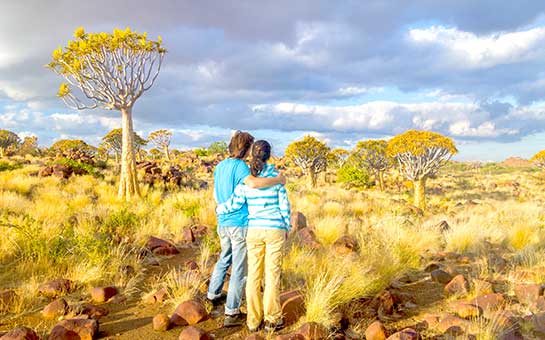Namibia is located in Southern Africa and has a stretch of Atlantic coastline on one side and the Zambezi River flowing on the other. The country has been home to the San, Damara, Nama, and Bantu people for centuries. Ovambo, one of the Bantu communities, is the predominant ethnic group at present.
Namibia was under German rule for some time. Its economy slowly started to improve with diamond mining. Later, it developed a thriving tourism sector with people coming from all over the world to experience its wildlife. Adventure sports have become another major draw.
Namibia is a melting pot with ethnic groups like Afrikaners, Germans, British, and Portuguese staying here in close harmony. You will get a chance to explore its varied culture once you visit, but before you visit, buy travel medical insurance as a safeguard against any unexpected accidents, illnesses, or injuries.
Namibia Travel Medical Insurance for International Travelers – FAQs
With Namibia travel medical insurance, you can rest easy about any expenses with regards to covered injuries or illnesses during your stay in the country.
Do I need travel medical insurance for Namibia?
Travel medical insurance is not legally required for Namibia. However, it is advisable to have health insurance so that it can cover the cost of approved treatment if you are injured during adventure sports, for example, or if you fall sick.
Why buy travel medical insurance for Namibia?
Namibia has so much to offer in terms of wildlife, trekking, and extreme sports. With Namibia travel medical insurance you will be able to enjoy all that without having to worry about medical expenses, just in case things take a turn for the worse.
It can also cover the cost of evacuation, provided it is included in your terms and conditions.
Things to Do for Travelers in Namibia
Here are some amazing things to experience in the country.
- Hike to Waterberg Plateau Park: You are sure to fall in love with the wild beauty of this plateau. The region is a photographer's delight, and hiking through the plateau trails will leave you exhausted but pumped with adrenaline. More than 200 species of birds reside here, including vultures. You can also spot buffalo, rhinoceroses, and antelopes in their natural habitats.
- Trip to Skeleton Coast National Park: This national park has an eerie story behind it. It was previously known for the skeletons strewn across the beaches that belonged to sailors who tried to guide their ships in the treacherous waters of the region. It is one of the largest shipping graveyards in the world even today, and the beach becomes very secluded after the evening.
- Safari at Etosha National Park: This is one of the best game reserves in the entire continent, and the safaris are almost always booked in advance. The park is located by the vast and arid Etosha salt pan. The heat and humidity created varied illusions at various times of the year. Watch zebras, flamingoes, elephants, and even their predators in their natural habitat.
- Visiting the famous Kalahari: The region has a portion of the Kalahari Desert, and it is quite an adventure heading out to the desert wild. You will meet many indigenous tribes—the San Hunter-Gatherers—and the red dunes are a sight to behold. Various wild animals like lions, hyenas, and the ever-curious meerkats live here.
- Enjoying Extreme sports: Namibia offers many opportunities for extreme sports like skydiving, sandboarding, quad biking, and even sandblasting. There are many tour operators here who will make all the arrangements. Some of the world's most difficult hiking and trekking trails are located here through the Fish River Canyon and around Victoria Falls.
Travel Risks for International Travelers in Namibia
Here are a few things to be careful of as you travel through Namibia.
- Insects & Urban Wildlife: Wear protective boots while hiking, and never leave your backpack around, as insects and reptiles could simply crawl into it.
- Driving dangers: If you have opted for a self-drive rental, then be careful of driving on Namibian roads. Be careful at the crossroads, and drive at a moderate speed to avoid accidents.
- ATM Thefts: If you find your ATM card not fitting into an ATM, try not to force it. In all probability, the machine has been tampered with.
- Water problems: While Namibia is one of the few African countries where it is probably safe to drink tap water, make sure you have full bottles to avoid scarcity and dehydration. Carry purification tablets or water filters if you have to drink from the tap or the stream.
Before You Travel to Namibia - Do This
- Make sure you have the required permits for hiking. There are several hiking trails, and some of them are restricted. Your permit will allow hassle-free entry.
- Always carry a water filter or purification tablets. Although the water in Namibia is fairly safe to drink, carry them nevertheless, especially if you are prone to stomach disorders.
- Carry bug repellants and invest in good hiking boots to avoid insect bites and mosquitoes.
- Make your reservations for adventure sports well in advance with licensed operators rather than randomly selecting any operator on arriving. They might offer lower rates, but they are not always safe.

